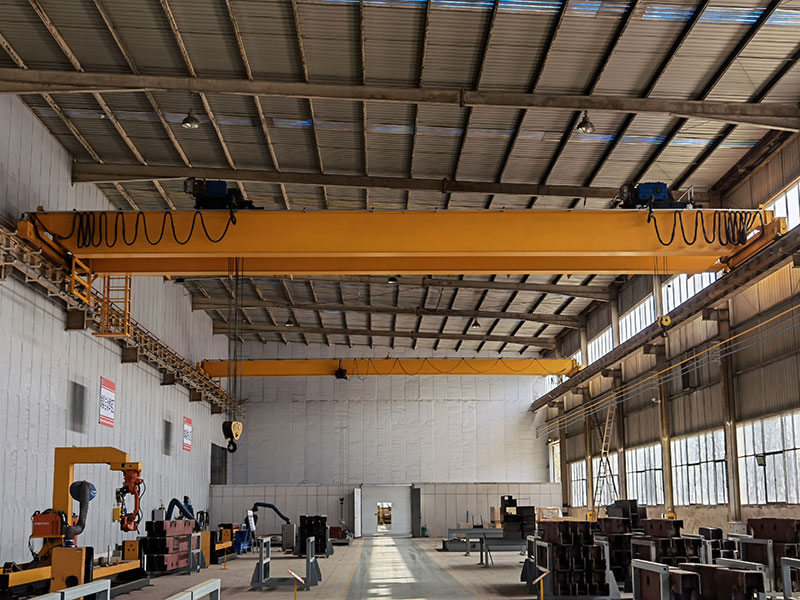Double girder overhead cranes are widely used in various industries for lifting and moving heavy loads with precision and efficiency. The successful installation of a double girder overhead crane requires careful planning, adherence to safety guidelines, and proper execution of installation methods. In this article, we will explore the essential methods and guidelines for installing a double girder overhead crane, ensuring a smooth and safe installation process.

Planning and Preparation of the Double Girder Overhead Crane Installation
Before beginning the installation process, thorough planning and preparation are essential. Consider the following factors:
a. Site Assessment: Assess the installation site, including the dimensions, floor conditions, overhead clearances, and structural integrity. Ensure that the site meets the requirements specified by the manufacturer and relevant industry standards.
b. Crane Specifications: Familiarize yourself with the overhead crane specifications, including load capacity, span length, lifting height, and any special features or requirements. This information will guide the installation process and determine the necessary equipment and tools.
c. Safety Considerations: Identify potential hazards and develop a comprehensive safety plan. Ensure that all necessary safety equipment and procedures are in place to protect the installation team, other personnel, and the surrounding environment.
d. Equipment and Resources: Determine the equipment and resources needed for installation, including cranes, hoists, lifting devices, tools, and skilled personnel. Ensure that all equipment is properly inspected, certified, and in good working condition.
Structural Analysis and Reinforcement of Double Girder Overhead Crane
Double girder overhead cranes exert significant loads on the supporting structure. It is crucial to conduct a structural analysis to determine if any reinforcement or modifications are necessary to accommodate the crane. Engage a qualified structural engineer to assess the existing structure’s capacity and provide recommendations for reinforcement, if required.
Assembly of Double Girder Overhead Crane Components
The installation process typically involves the assembly of various overhead crane components. Follow these guidelines:
a. Beam Installation: Install the double girders securely onto the supporting structure, ensuring proper alignment and leveling. Use appropriate lifting devices, such as cranes or jacks, to position the girders accurately.
b. End Carriage and Crab Assembly: Assemble the end carriages and crab units according to the manufacturer’s instructions. Align and attach them securely to the double girders, ensuring smooth movement and proper engagement with the runway system.
c. Electrical and Control System: Install the electrical components, including power cables, control panels, limit switches, and sensors. Follow the manufacturer’s wiring diagrams and ensure compliance with electrical codes and safety standards.
Runway System Installation
The runway system provides the track for the crane’s movement. Follow these steps for proper installation:
a. Runway Beam Installation: Install the runway beams securely onto the supporting structure, ensuring proper alignment, leveling, and adequate spacing between the beams. Verify that the runway beams are straight and parallel to facilitate smooth crane movement.
b. Rail Installation: Attach the rails to the runway beams, ensuring proper alignment and secure fastening. Use specialized tools and techniques to achieve accurate rail alignment and smooth transitions between rail sections.
Testing and Commissioning of Overhead Crane
Once the double girder overhead crane is fully installed, conduct thorough testing and commissioning to ensure its safe and efficient operation. Perform the following tasks:
a. Load Testing: Gradually apply load to the crane, testing its lifting capacity and stability. Monitor the crane’s performance, checking for any signs of stress, misalignment, or abnormalities.
b. Functional Testing: Test all crane functions, including hoisting, trolley movement, bridge movement, limit switches, emergency stop controls, and safety features. Verify that all controls and systems are functioning as intended.
c. Safety Inspections: Conduct comprehensive safety inspections, including checks for proper bolt tightening, wire rope condition, lubrication of moving parts, and overall structural integrity. Address any identified issues before putting the crane into regular operation.
Conclusion
The successful installation of a double girder overhead crane requires careful planning, adherence to safety guidelines, and meticulous execution of installation methods. By following the methods and guidelines outlined in this article, you can ensure a smooth and safe installation process, allowing the crane to operate efficiently and effectively. Remember to consult the manufacturer’s instructions and seek professional assistance as needed to ensure a successful installation.